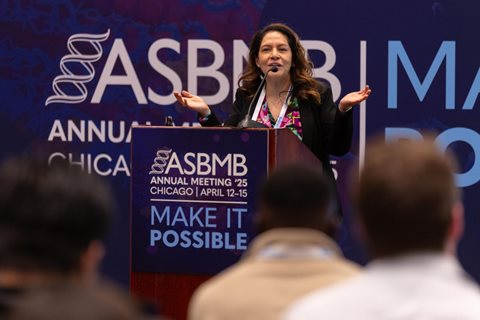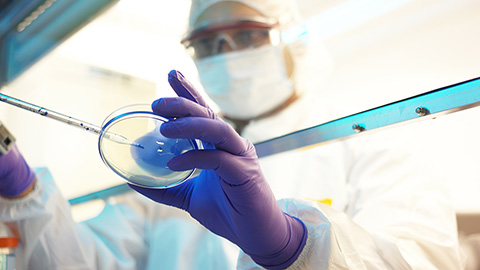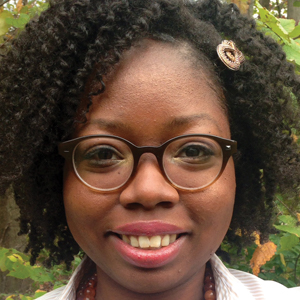A career supporting research innovation
I recently attended a few #BlackIn events and met a few scientists across various disciplines. For this week’s column, I talked to one of them about her journey from organic chemist to patent agent.
Kerisha Bowen was born in Trinidad and immigrated to Canada as a refugee when she was 5 years old. Her mother, a nurse, was soon recruited by Temple University Hospital in Philadelphia, so the family packed up again and made their home in America.

Bowen earned her bachelor’s degree in chemistry at Lincoln University, which is near where the states of Pennsylvania, Maryland and Delaware meet. She then did an eight-month biochemistry internship at Cephalon, a biopharmaceutical company that is now part of Teva Pharmaceutical Industries. She then decided to pursue a doctorate, focusing on the synthesis of nitrogen-based pharmaceuticals from sulfinimines, and became the first black woman to earn a Ph.D. in chemistry at Temple University.
After graduating, she took a postdoctoral position, supported by the Institutional Research and Academic Career Development Awards (IRACDA) program, at the University of Pennsylvania in Philadelphia. Her research focused on the metabolic role of protein tyrosine phosphate genes in obesity and diabetes. At the same time, she taught undergraduate chemistry at Lincoln University, her alma mater.
The IRACDA program seeks to develop a diverse group of scientists and promote partnerships between research-intensive institutions and teaching schools. Bowen said it was a great experience because it gave her access to networks and professional development.
“I went from just having four black scientists … to being around a whole bunch of minority postdocs,” she said. “We are still friends to this day.”
Still, Bowen experienced overt racism and racial inequalities in academia, which made her start looking for other options.
Ph.D. to J.D.
As a scientist, Bowen understood how to communicate complex ideas, scientific terminology and the research behind the technical methods, so a career in patent law fit the bill.
Required exams
The patent bar: The Examination for Registration to Practice in Patent Cases Before the United States Patent and Trademark Office is required for patent agents and patent attorneys. It is a 100-question, multiple-choice exam. You must take this exam to become a patent agent or patent attorney. Note: A lawyer cannot call themselves a patent attorney unless they actually passed the patent bar.
The bar exam: The Uniform Bar Examination (UBE) is required after law school for those who wish to become attorneys. It has three parts: Multistate Bar Examination (MBE), Multistate Essay Examination (MEE) and the Multistate Performance Test (MPT). You do not have to take and pass this exam to be a patent agent, but you must take and pass it to be a patent attorney.
“With patent law, you still get to know what is going on in the lab, help research and talk to different inventors,” she said.
She found a one-year patent law master’s program for scientists at the University of Notre Dame. Right after completing that program in 2013, Bowen started a position as a patent agent at the D.C. office of Dentons, the largest general practice firm in the world.
She earned her J.D. from George Washington University Law School this year.
Daily work life
Bowen’s work as a patent agent falls under intellectual property law, which is a branch of law that deals with the rights and protection of creation of products. This includes inventions such as a physical apparatus, methods of use or improvement. Intellectual property law is broken up into copyright (words or arts), trademark (image or phrase), patents and trade secrets.
At Dentons, Bowen drafts patent applications for potential drugs and drug targets, corresponds with the U.S. Patent and Trademark Office and reviews data and clinical trial information in the Food and Drug Administration’s Orange Book to prepare applications for FDA approvals.
“I’m currently working on two litigation cases, so I’m having some Zoom depositions, which is a little weird. I’ll work on a trial in the afternoon, and then I'll draft a patent application for my clients,” she said.
And, of course, there’s plenty of paperwork.
Below, Bowen has provided advice for scientists thinking about patent law careers. Also make sure to check out the box about the types of exams that are required. Finally, follow Bowen on Twitter and other #BlackinChem scientists to learn more about their careers.
Bowen’s advice for scientists interested in patent law
Explore your options: Patent prosecution professionals attempt to obtain patent protection for inventions. Law firms employ patent technical specialists (don’t have to pass the patent bar), patent agents (must pass the patent bar) and patent attorneys (must pass the patent bar and have a law degree). (See box about exams.)
Consider a master’s degree in patent law: Bowen did this. This option is not required, but it will prepare you for the patent bar.
You do not have graduate from law school to work as a patent agent. It is a common misconception that you need a law degree to work as a patent agent. You do need a law degree to be a patent attorney, however.
Take the patent bar before you start applying to law school. This exam is a good preview of what to expect in the patent law field. Law firms generally pay for patent agents’ law school tuition. Although this is not guaranteed, you should try to negotiate for it. Full-time law students typically take three years to graduate and part-time students typically take four years. Having said that, it can longer.
Featured jobs
from the ASBMB career center
Enjoy reading ASBMB Today?
Become a member to receive the print edition four times a year and the digital edition monthly.
Learn moreFeatured jobs
from the ASBMB career center
Get the latest from ASBMB Today
Enter your email address, and we’ll send you a weekly email with recent articles, interviews and more.
Latest in Careers
Careers highlights or most popular articles

Building the blueprint to block HIV
Wesley Sundquist will present his work on the HIV capsid and revolutionary drug, Lenacapavir, at the ASBMB Annual Meeting, March 7–10, in Maryland.

Upcoming opportunities
Present your research alongside other outstanding scientists. The #ASBMB26 late-breaking abstract deadline is Jan. 15.

Designing life’s building blocks with AI
Tanja Kortemme, a professor at the University of California, San Francisco, will discuss her research using computational biology to engineer proteins at the 2026 ASBMB Annual Meeting.

Upcoming opportunities
#ASBMB26 late-breaking abstract submission opens on December 8. Register by Jan. 15 to get the early rate on our Annual Meeting.

Make your abstract stand out
Ensure your research is impossible to overlook. Get quick, practical reminders for crafting an abstract that attracts readers and helps you build connections at the conference.

Inside industry postdocs
As more Ph.D. scientists look beyond academia, industry postdocs offer a new kind of training, where mentorship meets mission-driven research. Fellows at Pfizer and Genentech share how these programs prepare them to translate discovery into impact.

